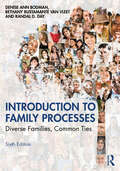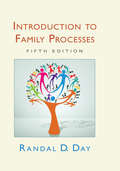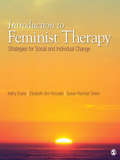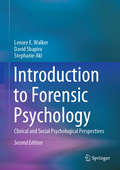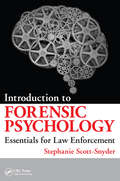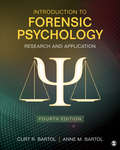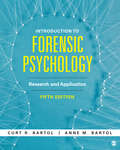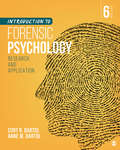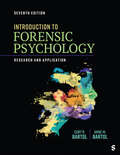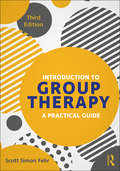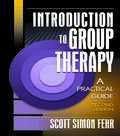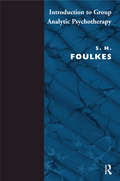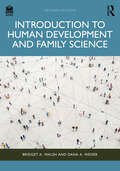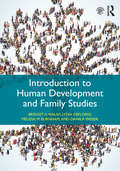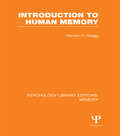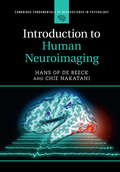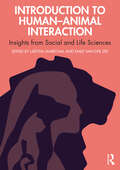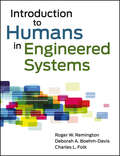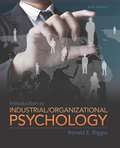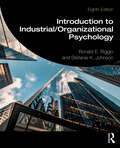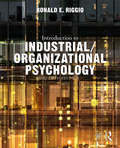- Table View
- List View
Introduction to Family Processes: Diverse Families, Common Ties
by Randal D. Day Denise Ann Bodman Bethany Bustamante Van VleetIntroduction to Family Processes: Diverse Families, Common Ties serves to provide an explanation of the complex workings of inner family life. The text primarily focuses on family processes and dynamics (the "inside" of families) as opposed to sociological trends, political topics, or the individual psychological approach. The text further presents the research underlying these processes and effectively presents ways to increase the positive aspects of family life. This edition has been updated to include current research and contemporary topics. The text has been divided into four parts: Foundations, Building and Establishing Families, Maintaining Families, and Change/Turbulence/Gains/Losses. While the research methods chapter still provides an introductory examination of family science research, it now includes an expanded discussion on research design, methods, and advances in the area. A new chapter, titled "Forgiveness, Kindness, Hope, and Gratitude" has been incorporated to amplify positive family processes and highlight emerging research. This edition provides added emphasis on diverse families (e.g., race/ethnicity, family structure, LGBTQIA, ability, culture, and family formation), and each chapter includes a new "Discussions in Diversity" section related to that chapter. The authors have consciously included an epilogue as a way of reflecting on what they have learned, along with what they hope to learn in the future. Aimed at courses related to family studies and family dynamics, this text provides a comprehensive review of family processes. Whether it is used for undergraduate or graduate classes, professional growth, or personal enrichment, the text assists readers in enhancing the positive aspects of family life, avoiding undesirable aspects, and more effectively managing the challenges and obstacles families face that cannot be avoided. Thus, the text holds an appeal for people who live (or will live) in families, as well as those who want to work with families.
Introduction to Family Processes: Fifth Edition
by Randal D. DayWhat goes on "behind closed doors" in families is examined in this text. Through his storytelling style, Randy Day introduces readers to the family processes approach – the strategies and behaviors families use to achieve goals. The emphasis is on how families work and interact rather than on the psychological, sociological, or economic processes. It examines emotions in families, communication, relationship formation/dissolution, family rituals, and power and conflict. Chapters open with a Preview and conclude with a Summary, Study Questions, Key Terms, and Suggested Readings. Principle Boxes highlight key concepts and a Glossary defines the key terms listed at the ends of the chapters. Significantly updated with 50% new material including many new references and examples, the new edition features: A new chapter that introduces the discipline’s methodology A new chapter on relationship formation including partner selection, falling in love, commitment, sexuality, passion, and intimacy A new design reformatted to tie in with the book’s website at http://www.psypress.com/family-processes which now contains the Chapter Activity Questions that reinforce critical thinking skills, the Journal Activities that strengthen students' personal connection to the material, and the chapter Previews and Key Terms for review purposes An Instructor’s Web Resource at http://www.psypress.com/family-processes with small group and in-class exercises, lecture outlines in PowerPoint, topics for debate, suggested films, and multiple-choice, true/false, matching, and essay questions More material on the role of gender, power, genetics, and personality in relationships; families from diverse cultural and ethnic backgrounds and the impact of work and technology on the family; the changing nature of family structures including single parenting and gay unions; and stresses in family life. Written for undergraduate courses on family processes, family dynamics, family life, the family, and/or marriage & family interaction taught in family studies, human development, psychology, sociology, social work, education, consumer sciences, home economics, health, and nursing departments, this book also appeals to those who want to maximize the positive parts of family life and manage the inevitable challenges.
Introduction to Feminist Therapy: Strategies for Social and Individual Change
by Dr Kathy M Evans Dr Elizabeth A. Kincade Susan Rachael SeemFocusing on the practical application of feminist theory to clinical experience, Introduction to Feminist Therapy provides guidelines to help therapists master social action and empowerment techniques, feminist diagnostic and assessment strategies, and gender-role and power analyses to foster individual and social change. This guide is ideal for graduate students enrolled in a techniques of counseling course and practitioners who wish to incorporate feminist therapy into their current approach, including how to apply feminist therapy to both women and men and how to deal with the gender issues of both sexes. Client/Therapist dialogues provide readers with examples of how each technique actually works in a therapeutic session. The text also provides case studies, coverage of ethical issues, and feminist assessment guidelines that show readers how to conduct a feminist assessment with and without using the DSM-IV-TR.
Introduction to Forensic Psychology: Clinical and Social Psychological Perspectives
by David Shapiro Lenore E. Walker Stephanie AklThis book provides a broad overview of the history and practice of forensic psychology, illustrating the principles of how psychological knowledge can inform judges and juries in the U.S. legal system with reference to several high publicity cases. The second edition contains new case law and discusses its implications in the major areas of forensics, examining new developments in juvenile justice, malpractice complaints, and reproductive rights, among other topics. The authors address specific aspects of forensic psychology within seven distinct sections:What is Forensic Psychology?Understanding the Criminal MindCan Psychologists Measure Pain and Suffering?Family Law and Fitness to ParentJuvenile JusticeLegal Consultation Based on Social PsychologyPractical Tips for Forensic Psychology Experts An essential resource for current and aspiring forensic psychologists, the second edition of Introduction to Forensic Psychology serves as a thorough introduction to a complex field, featuring updated cases and related legal developments.
Introduction to Forensic Psychology: Essentials for Law Enforcement
by Stephanie Scott-SnyderResearch indicates that there are psychological principles at play in the situations encountered by law enforcement personnel. The book fulfills an important need in the ever-evolving field of criminal justice, providing a working knowledge of forensic psychology and its application to interview strategies, homicide, emotional disturbance, sexual and domestic violence, hostage negotiations, and other situations. It will help law enforcement to understand, interpret, and anticipate behavior, while responding safely and effectively.
Introduction to Forensic Psychology: Research and Application
by Anne M. Bartol Curtis R. BartolFilled with real–life examples, practical applications, and case law discussions, Forensic Psychology: Research and Application, Fourth Edition covers new and emerging fields of study, the many areas where psychology plays a significant role in the civil and criminal justice systems, and the wide range of issues that are an integral part of the forensic psychologist’s day-to-day work. This unique, career-oriented textbook emphasizes a multicultural perspective that focuses on the application of psychological knowledge and research. Authors Curt and Anne Bartol expose readers to emerging specializations within forensic psychology, including investigative psychology, family forensic psychology, and police and public safety psychology. The authors also provide extensive, up-to-date references for students to find more material on the subject areas covered.
Introduction to Forensic Psychology: Research and Application
by Anne M. Bartol Curtis R. BartolFilled with real–life examples, practical applications, and case law discussions, Forensic Psychology: Research and Application, Fourth Edition covers new and emerging fields of study, the many areas where psychology plays a significant role in the civil and criminal justice systems, and the wide range of issues that are an integral part of the forensic psychologist’s day-to-day work. This unique, career-oriented textbook emphasizes a multicultural perspective that focuses on the application of psychological knowledge and research. Authors Curt and Anne Bartol expose readers to emerging specializations within forensic psychology, including investigative psychology, family forensic psychology, and police and public safety psychology. The authors also provide extensive, up-to-date references for students to find more material on the subject areas covered.
Introduction to Forensic Psychology: Research and Application
by Curt R. Bartol Anne M. BartolWritten by authors with extensive experience in the field and in the classroom, Introduction to Forensic Psychology: Research and Application, Fifth Edition, by Curt R. Bartol and Anne M. Bartol, demonstrates how to analyze psychological knowledge and research findings and then apply these findings to the civil and criminal justice systems. Focusing on research-based forensic practice and practical application, this text uses real-life examples and case law discussions to define and explore forensic psychology. This text introduces you to emerging specializations within forensic psychology, including investigative psychology, family forensic psychology, and police and public safety psychology. You will develop a multicultural perspective with an ethnic and racial sensitivity, which is critical to the successful practice of forensic psychology. New to the Fifth Edition: Updated statistics, research, and case law, such as recent Aid in Dying legislation, as well as analysis of recent events, help you see the real-world applications to current events. Updated Focus boxes empower you to dig deeper into current issues, such as mental health courts, community-oriented policing, child abduction, hate crimes, the death penalty, and more. All Focus boxes also contain discussion questions for you to debate in a classroom setting. All new From My Perspective boxes provide you with information about career choices as well as helpful advice about pursuing your career goals. Increased attention to immigration-related issues offers you additional insights into immigration proceedings and ways to consult with the courts. Additional coverage of human trafficking and online sexual predators enables you to better understand the psychological effects on victims and the services available to help. Current research on violent video games, cyberbullying, and cyberstalking provides real examples of the effects of violent media. New research on juveniles allows you to see the important contributions of neuropsychologists, particularly in terms of brain development in adolescents and promising community-based treatment approaches for juveniles.
Introduction to Forensic Psychology: Research and Application
by Curt R. Bartol Anne M. BartolWritten by authors with extensive experience in the field and in the classroom, Introduction to Forensic Psychology: Research and Application, Fifth Edition, by Curt R. Bartol and Anne M. Bartol, demonstrates how to analyze psychological knowledge and research findings and then apply these findings to the civil and criminal justice systems. Focusing on research-based forensic practice and practical application, this text uses real-life examples and case law discussions to define and explore forensic psychology. This text introduces you to emerging specializations within forensic psychology, including investigative psychology, family forensic psychology, and police and public safety psychology. You will develop a multicultural perspective with an ethnic and racial sensitivity, which is critical to the successful practice of forensic psychology. New to the Fifth Edition: Updated statistics, research, and case law, such as recent Aid in Dying legislation, as well as analysis of recent events, help you see the real-world applications to current events. Updated Focus boxes empower you to dig deeper into current issues, such as mental health courts, community-oriented policing, child abduction, hate crimes, the death penalty, and more. All Focus boxes also contain discussion questions for you to debate in a classroom setting. All new From My Perspective boxes provide you with information about career choices as well as helpful advice about pursuing your career goals. Increased attention to immigration-related issues offers you additional insights into immigration proceedings and ways to consult with the courts. Additional coverage of human trafficking and online sexual predators enables you to better understand the psychological effects on victims and the services available to help. Current research on violent video games, cyberbullying, and cyberstalking provides real examples of the effects of violent media. New research on juveniles allows you to see the important contributions of neuropsychologists, particularly in terms of brain development in adolescents and promising community-based treatment approaches for juveniles.
Introduction to Forensic Psychology: Research and Application
by Anne M. Bartol Curtis R. BartolWritten by authors with extensive experience in the field and in the classroom, Introduction to Forensic Psychology: Research and Application, Sixth Edition demonstrates how to analyze psychological knowledge and research findings and apply these findings to the civil and criminal justice systems. Focusing on research-based forensic practice and practical application, the authors use real-life examples and case law discussions to define and explore forensic psychology. Students are introduced to emerging specializations within forensic psychology, including investigative psychology, family forensic psychology, and police and public safety psychology. Research related to bias, diversity, and discrimination is included throughout the text to give students a multicultural perspective that is critical to the successful practice of forensic psychology. Included with this title: Instructor Online Resources: Access online resources for this title via the password-protected Instructor Resource Site.
Introduction to Forensic Psychology: Research and Application
by Anne M. Bartol Curtis R. BartolWritten by authors with extensive experience in the field and in the classroom, Introduction to Forensic Psychology: Research and Application, Sixth Edition demonstrates how to analyze psychological knowledge and research findings and apply these findings to the civil and criminal justice systems. Focusing on research-based forensic practice and practical application, the authors use real-life examples and case law discussions to define and explore forensic psychology. Students are introduced to emerging specializations within forensic psychology, including investigative psychology, family forensic psychology, and police and public safety psychology. Research related to bias, diversity, and discrimination is included throughout the text to give students a multicultural perspective that is critical to the successful practice of forensic psychology. Included with this title: Instructor Online Resources: Access online resources for this title via the password-protected Instructor Resource Site.
Introduction to Forensic Psychology: Research and Application
by Curtis R. Bartol Anne M. BartolWritten by authors with extensive experience in both the field and classroom, Introduction to Forensic Psychology: Research and Application, Seventh Edition equips students with the skills to analyze psychological knowledge and research findings, applying them effectively to both civil and criminal justice systems. The text is structured to cover five vital areas: law enforcement and investigative psychology, legal psychology, criminal psychology, victimology and victim services, and correctional psychology, while also addressing emerging technologies such as facial recognition and artificial intelligence. Moreover, it emphasizes an essential multicultural perspective, underscoring the need for sensitivity to ethnic, gender, cultural, and racial dynamics, preparing students to navigate the diverse challenges they will encounter in their professional careers.
Introduction to Forensic Psychology: Research and Application
by Curtis R. Bartol Anne M. BartolWritten by authors with extensive experience in both the field and classroom, Introduction to Forensic Psychology: Research and Application, Seventh Edition equips students with the skills to analyze psychological knowledge and research findings, applying them effectively to both civil and criminal justice systems. The text is structured to cover five vital areas: law enforcement and investigative psychology, legal psychology, criminal psychology, victimology and victim services, and correctional psychology, while also addressing emerging technologies such as facial recognition and artificial intelligence. Moreover, it emphasizes an essential multicultural perspective, underscoring the need for sensitivity to ethnic, gender, cultural, and racial dynamics, preparing students to navigate the diverse challenges they will encounter in their professional careers.
Introduction to Group Therapy: A Practical Guide (Third Edition)
by Scott Simon FehrThe main objective of Introduction to Group Therapy is to give the reader a solid understanding of group therapy while simultaneously creating scholars in the group therapy paradigm. This unique book combines theory and practice in a reader-friendly format, presenting practical suggestions to guide both students and novice group therapists through the nuts and bolts of running a group. This third edition continues the clinically relevant and highly readable work of the previous editions, demonstrating the therapeutic power group therapy has in conflict resolution and personality change. A proven resource for introductory and advanced coursework, the book promotes group therapy at the grassroots level – students – where it has the most opportunity to be put into effect.
Introduction to Group Therapy: A Practical Guide, Second Edition
by Scott Simon FehrProvides a solid foundation for anyone interested in group therapy! Introduction to Group Therapy: A Practical Guide, Second Edition continues the clinically relevant and highly readable work of the original, demonstrating the therapeutic power group therapy has in conflict resolution and personality change. This unique book combines theory and practice in a reader-friendly format, presenting practical suggestions in areas rarely covered in academic settings. A proven resource for introductory and advanced coursework, the book promotes group therapy at the grassroots level-students-where it has the most opportunity to be put into effect. Introduction to Group Therapy: A Practical Guide, Second Edition expands on issues presented in the book's first edition and introduces new information on topics such as the historical beginnings of group therapy, theories, modalities, practical issues of how to set up an office for an effective group environment, surviving your training sites, problem clients, contemporary issues drawn from online discussion, and developing a group practice. The book also includes case studies, review questions, a glossary, appendices of relevant topics, and an extensive bibliography. Changes to Introduction to Group Therapy: A Practical Guide include: the expansion of "A Case Study" into two chapters to include analysis from 17 senior clinicians a new chapter on group therapy as a negative experience a new chapter on group psychotherapy as a specialty new material on self-protection new material on the training site and the problematic client and much more! Thorough, well organized, and based on first-hand accounts, this book is also a great resource for experienced clinicians who need proven and expert advice from colleagues in the field. Introduction to Group Therapy, Second Edition effectively combines theory and practical suggestions to help you offer improved therapy to clients.
Introduction to Group-Analytic Psychotherapy: Studies in the Social Integration of Individuals and Groups
by S.H. FoulkesGroup Analysis, the approach pioneered by Foulkes, is a form of psychotherapy in small groups and also a method of studying groups and the behaviour of individuals in their social aspects. Apart from a number of practical advantages, it has features of specific value. It is the method of choice for the investigation of many problems and for the treatment of many disturbances.
Introduction to Human Development and Family Science
by Bridget A. Walsh Dana A. WeiserNow in its second edition, Introduction to Human Development and Family Science was the first text to introduce human development and family studies (HDFS) as inextricably linked areas of study. Pioneers of research paradigms have acknowledged that the family is one setting in which human development occurs, and much work is inherently multidisciplinary and interdisciplinary. This book helps to fortify an understanding of HDFS and subareas within it.Key features include: Chapters aligned with Certified Family Life Educator (CFLE) Guidelines. An applied focus, with vignettes exploring diverse family structures and human experience, a brand-new appendix with helpful tips to encourage the effective utilization of research. Discussion of the wide variety of career paths for HDFS students. Rich pedagogical features, including Challenge: Integration sections, bringing together content from all chapters; Journal Questions, encouraging reflection on content as well as personal experience; and Suggested Resources, listing relevant websites, books, articles, and video links for further study. Incredibly user-friendly, this is essential reading for students new to Human Development and Family Science.A fully developed Instructor and Student Website includes flashcards, self-testing quizzes, and discussion questions for students, as well as activities, lecture slides, test banks, and video recommendations for instructors.
Introduction to Human Development and Family Studies
by Bridget A. Walsh Dana A. Weiser Lydia Deflorio Melissa M. BurnhamIntroduction to Human Development and Family Studies is the first text to introduce human development and family studies (HDFS) as inextricably linked areas of study, giving students a complex yet realistic view of individuals and families. Pioneers of research paradigms have acknowledged that the family is one setting in which human development occurs. Moreover, in many academic programs, the lines of these two disciplines blur and much work is inherently multidisciplinary and interdisciplinary. This book helps to fortify an understanding of HDFS and subareas within it. Vignettes from current HDFS students as well as new professionals, an overview of the lifespan stage(s) within the family context, a wide description of research methods and applications, current policy issues relevant to the area, and discussions of practice/careers coupled with strategies for pursuing specializations or careers in the area are hallmarks of this textbook. Introduction to Human Development and Family Studies is essential reading for students new to the major and minor wanting to know: What is HDFS? Who are the people involved in HDFS? Why is HDFS important? How does theory and research inform work in HDFS? What does the pursuit of being an ethical professional require? What are the key areas in HDFS? Incredibly user-friendly both on the page and online, the text also features the following resources: Chapter Summaries where the main points of each chapter are pinpointed at the end of every chapter for review and study. Key Terms listed and defined within the margins of every chapter, a complete Glossary at the end of the text, and Flashcards online for additional review and study. Challenge: Integration section at the end of each chapter that underscores concepts from the chapter and draws connections between content presented in other chapters. Journal Questions to encourage reflection about the content and encourage thinking about some of the content coupled with students’ own experiences. Suggested Resources that lists relevant websites, books, articles, and video links for further study. A Closer Look at Applied Experiences Appendix outlines the internship process and shows how the internship experience can be meaningful and useful, and a Consuming Research Appendix that focuses on what it means to be a consumer of research, the knowledge and skills consumers need, and considerations for transitioning from a consumer of research to a producer of research.
Introduction to Human Memory (Psychology Library Editions: Memory)
by Vernon GreggOriginally published in 1986, this book was written for undergraduates who had completed an introductory course in psychology, and aimed to acquaint the student with the core of recent experimental findings and theoretical ideas concerning human memory. Each chapter deals with a specific area of memory research but care is taken to build on what has been covered in preceding chapters, so providing an integrated treatment of the subject. Thus, the book can comfortably be read from cover to cover, or selected issues can be referred to in isolation. Important features of the book include discussion of fundamental issues about the nature of the scientific process, the role of models and theories in it, and the historical development of models of human memory. Also, the treatment of ‘Forgetting’ includes chapters on motivational aspects (psychopathological forgetting, post-hypnotic amnesia, and directed forgetting), and organic amnesia.
Introduction to Human Neuroimaging (Cambridge Fundamentals of Neuroscience in Psychology)
by Hans Op de Beeck Chie NakataniDeveloped specifically for students in the behavioral and brain sciences, this is the only textbook that provides an accessible and practical overview of the range of human neuroimaging techniques. Methods covered include functional and structural magnetic resonance imaging, positron emission tomography, electroencephalography, magnetoencephalography, multimodal imaging, and various brain stimulation methods. Experimental design, image processing, and statistical inference are also addressed, with chapters for both basic and more advanced data analyses. Key concepts are illustrated through research studies on the relationship between brain and behavior, and practice questions are included throughout to test knowledge and aid self-study. Offering just the right amount of detail for understanding how major imaging techniques can be applied to answer neuroscientific questions, and the practical skills needed for future research, this is an essential text for advanced undergraduate and graduate students in psychology, neuroscience, and cognitive science programs taking introductory courses on human neuroimaging.
Introduction to Human-Animal Interaction: Insights from Social and Life Sciences
by Laëtitia Maréchal van der Zee, EmileIntroduction to Human-Animal Interaction focuses on the human dimension of interacting with other animals. This book introduces recent developments, theories, and debates in the relatively new research area of Human-Animal Interaction (HAI) and focuses on the social and life sciences aspect of these interactions. Experts from different academic disciplines provide an overview for students and professionals interested in how humans and other animals interact, and what advantages and disadvantages emerge for both parties in this relationship. The book starts with the theories and mechanisms supporting our interactions with animals, such as human-animal communication, and it then covers the implications of HAI in terms of ethics and welfare. After discussing cultural differences and forensic aspects in human-animal interaction (e.g., wildlife crime and animal abuse), the book examines evidence in the area of animal-assisted intervention. The final chapters give an overview of current research in specific human-animal interaction systems: human-pet, human-livestock and human-wildlife interaction. The book offers a scientific, evidence-based perspective on human-animal interaction, providing pedagogical tools to make a systematic, critical and constructive evaluation of research in HAI possible. It offers a range of in-text pedagogical features like a subject index, chapter MCQs, open questions, further reading, and additional digital resources including videos which are accessible via QR codes or through the associated website. This textbook provides the fundamental tools for achieving a comprehensive, current, and critical overview of the HAI field and is an integral text for undergraduate and postgraduate students undertaking modules in human-animal interaction, in social sciences such as anthropology, cultural studies, criminology, ethics and laws or in life sciences such as animal behaviour, conservation and welfare, biology, neuroscience, physiology, psychology, public health and those studying veterinary science.
Introduction to Humans in Engineered Systems
by Charles L. Folk Roger Remington Deborah A. Boehm-DavisFully up-to-date coverage of human factors engineering-plus online access to interactive demonstrations and exercisesEngineering accomplishments can be as spectacular as a moon landing or as mundane as an uneventful drive to the local grocery store. Their failures can be as devastating as a plane crash or a massive oil spill. Over the past decade, psychologists and engineers have made great strides in understanding how humans interact with complex engineered systems-human engineering. Introduction to Humans in Engineered Systems provides historical context for the discipline and an overview of some of the real-world settings in which human engineering has been successfully applied, including aviation, medicine, computer science, and ground transportation. It presents findings on the nature and variety of human-engineering environments, human capabilities and limitations, and how these factors influence system performance. Important features include:Contents organized around the interaction of the human operator with the larger environment to guide the analysis of real-world situationsA web-based archive of interactive demonstrations, exercises, and links to additional readings and tools applicable to a range of application domainsWeb content customizable for focus on particular areas of study or research
Introduction to Industrial and Organizational Psychology
by Ron RiggioDemonstrates the connection between psychological theory and application in the field of Industrial / Organizational Psychology. Introduction to Industrial / Organizational Psychology is a student-centered, real-world driven program designed and written with the student in mind, giving examples and illustrations relevant to their world of work. The sixth edition continues to be accessible to students while maintaining a comprehensive coverage of the classical and new topics.With more student-oriented features, instructors will find this the most thoroughly referenced I/O psychology and student accessible text on the market. Learning Goals Upon completing this book, readers will be able to: * Connect psychological theory in the field of industrial/organizational psychology and apply the concepts to their everyday world of work * Be familiar with "classic" theories and research along with the latest developments and innovations in the field * Understand the overview of the world of work.
Introduction to Industrial/Organizational Psychology
by Ronald E. Riggio Stefanie K. JohnsonIntroduction to Industrial/Organizational Psychology provides a complete overview of the psychological study of the world of work. Written with the student in mind, the book presents classic theory and research in the field alongside examples from real-world work situations to provide deeper insight. This edition has been thoroughly updated to include the latest research on each key topic, and now features: A spotlight on diversity, equity, and inclusion throughout, including coverage of LGBTQIA+ inclusion and racial justice Expanded coverage of ethics in I/O psychology practice Increased emphasis on cross-cultural and international issues Coverage of the changing nature of work, post-pandemic, including remote working, worker stress, and burnout A new focus on technologies related to I/O such as virtual reality and computer adaptive testing New figures, illustrations, and charts to grab the reader’s attention and facilitate learning Accompanied by extensive student and instructor resources, it is a must read for all students on I/O psychology courses and courses in work psychology and organizational behavior, and for practicing managers who want a comprehensive overview of the psychology of work.
Introduction to Industrial/Organizational Psychology (Seventh Edition)
by Ronald E. Riggio<p>Introduction to Industrial/Organizational Psychology provides an accessible approach to psychological theory and its applications to the world of work. Using both classic theories and research along with the latest developments and innovations, this student-centered text shows practical applications of theoretical concepts using examples from work situations that students may be familiar with—such as service industries, internet companies, and startups—in addition to traditional office and factory work settings. Each chapter includes key terms and review questions, and the text features special sections highlighting applications of I/O psychology theories, psychological approaches to everyday work situations, and current areas of research and practice. <p>The seventh edition is thoroughly updated to include the latest research on each key topic. It also includes expanded coverage of international issues, job engagement, and emerging topics in the field, such as workplace bullying, virtual teams and organizations, agile organization structures, and web-based training and assessment. The book will be of interest to undergraduate students in introductory I/O psychology or psychology of work behavior courses. <p>For additional resources, please consult the Companion Website at www.routledge.com/cw/riggio, where instructors will find an expanded instructor’s manual, test bank, and lecture slides, and students will find chapter summaries and learning objectives.</p>
